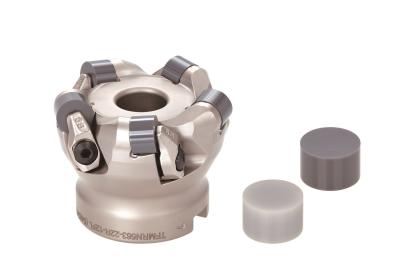
Tungaloy introduces CeramicSpeedMill for efficient milling of heat-resistant superalloys (HRSAs).
CeramicSpeedMill offers round ceramic inserts for milling HRSAs efficiently at elevated feeds and speeds. The negative, economical double-sided ceramic inserts offer superior cutting edge integrity. In addition, the new TS200 and TS300 of SiAlON ceramics grades combined with the close-pitch cutter design enables milling of nickel-base superalloys at cutting speeds of over 500 meters per minute (1,640 sfm) and greater feed rates for efficient milling of HRSAs commonly used for aerospace components.
Two standard ceramic grades are available: TS200 is a universal grade for finishing, while TS300 is designed for descaling and other roughing applications. The cutter body is offered in a bore (shell mill) style in diameters of 63 mm and 80 mm, and 2.5" and 3.0" for the inch market.
At a Glance:
Ceramic facemill with round ceramic inserts designed for machining heat-resistant superalloys
New SiAlON ceramic grade inserts provide wear and fracture resistance when machining at high feeds and speeds
Two cutter bodies and four inserts to be added
Contact Details
Related Glossary Terms
- ceramics
ceramics
Cutting tool materials based on aluminum oxide and silicon nitride. Ceramic tools can withstand higher cutting speeds than cemented carbide tools when machining hardened steels, cast irons and high-temperature alloys.
- facemill
facemill
Milling cutter for cutting flat surfaces.
- feed
feed
Rate of change of position of the tool as a whole, relative to the workpiece while cutting.
- gang cutting ( milling)
gang cutting ( milling)
Machining with several cutters mounted on a single arbor, generally for simultaneous cutting.
- milling
milling
Machining operation in which metal or other material is removed by applying power to a rotating cutter. In vertical milling, the cutting tool is mounted vertically on the spindle. In horizontal milling, the cutting tool is mounted horizontally, either directly on the spindle or on an arbor. Horizontal milling is further broken down into conventional milling, where the cutter rotates opposite the direction of feed, or “up” into the workpiece; and climb milling, where the cutter rotates in the direction of feed, or “down” into the workpiece. Milling operations include plane or surface milling, endmilling, facemilling, angle milling, form milling and profiling.
- superalloys
superalloys
Tough, difficult-to-machine alloys; includes Hastelloy, Inconel and Monel. Many are nickel-base metals.

